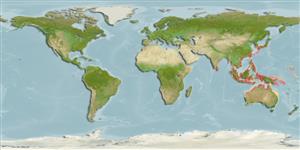Teleostei (teleosts) >
Syngnathiformes (Pipefishes and seahorses) >
Solenostomidae (Ghost pipefishes)
Etymology: Solenostomus: Greek, solen = tube + Greek, stoma = mouth (Ref. 45335).
Environment: milieu / climate zone / depth range / distribution range
Ecology
Marine; reef-associated; depth range 0 - 10 m (Ref. 90102). Tropical
Distribution
Countries | FAO areas | Ecosystems | Occurrences | Point map | Introductions | Faunafri
Indo-Pacific: from East Africa to Australia, north to Japan; confirmed East Indian records from Indonesia and Malaysia.
Size / Weight / Age
Maturity: Lm ? range ? - ? cm
Max length : 12.0 cm TL male/unsexed; (Ref. 90102)
Short description
Identification keys | Morphology | Morphometrics
Dorsal spines (total): 5; Dorsal soft rays (total): 18 - 21; Anal soft rays: 18 - 21. This species usually with prominent filamentous appendages along the ventral surface of the snout and may also have shorter appendages along the dorsal surface. Some individuals have 'hairy' filamentous appendages covering head, body and fins. Body with variable shades of brown, red and green, often with white mottling (Ref. 90102).
Found in algal/rubble reefs and sandy bottoms, often at depths below 10 m (Ref. 90102). Mostly pelagic until they settle on the substrate for breeding (Ref. 48635).
Life cycle and mating behavior
Maturity | Reproduction | Spawning | Eggs | Fecundity | Larvae
Allen, G.R. and M.V. Erdmann, 2012. Reef fishes of the East Indies. Perth, Australia: Universitiy of Hawai'i Press, Volumes I-III. Tropical Reef Research. (Ref. 90102)
IUCN Red List Status (Ref. 130435: Version 2024-2)
Threat to humans
Harmless
Human uses
Tools
Special reports
Download XML
Internet sources
Estimates based on models
Preferred temperature (Ref.
123201): 23.3 - 29.3, mean 28.7 °C (based on 1453 cells).
Phylogenetic diversity index (Ref.
82804): PD
50 = 0.5312 [Uniqueness, from 0.5 = low to 2.0 = high].
Bayesian length-weight: a=0.01000 (0.00244 - 0.04107), b=3.04 (2.81 - 3.27), in cm total length, based on all LWR estimates for this body shape (Ref.
93245).
Trophic level (Ref.
69278): 3.6 ±0.5 se; based on size and trophs of closest relatives
Fishing Vulnerability (Ref.
59153): Low vulnerability (10 of 100).
